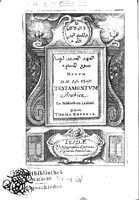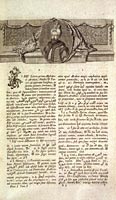The Middle East and Religion
|

Inscribed with much of the text of the Koran, this
eighteenth-century linen Shiite Muslim battle tunic, most
probably from Iran or southern Iraq, also bears inscriptions
in praise of the prophet Muhammad and of his son-in-law,
Ali. It is eloquent testimony to the place of religious
commitment in all aspects of life in the Islamic world.
Across the shoulders is inscribed verse 13 of Surah
61 ("al Saff," or Battle array): "Help from God and
a speedy Victory. So give the Glad Tidings to the Believers."
(Near
East Section)
|
To overemphasize the role that religious beliefs have played
in all aspects of Middle Eastern society and culture is impossible.
Three of the world's major religions, as well as smaller sects
that continue to exist today, arose from these lands. Up to modern
times in the Near East, religion and politics were inseparable,
and to some extent this is still true today. For the majority
of these peoples, their primary identity has been religious. People
thought of themselves first as Muslims, Christians, Jews, or Zoroastrians,
and second as a member of some ethnicity or as an inhabitant of
a specific locality. This primary identification with religion
had the deepest of roots, extending back to the most ancient Mesopotamian
states. During the Sasanian dynasty of Persia (A.D. 224- 636),
the system of separate religious communities, governed by their
own religious leaders under the authority of the king of kings,
was crystallized. This religious and political identification
was paralleled at roughly the same time in the Greek orthodoxy
of the Byzantine Empire. In the seventh century A.D., when the
Sasanian Empire fell to the Arabs, the empire's administrative
structure lived on in the Islamic concept of Ahl al-Kitab (People
of the Book). Ahl al-Kitab embraced those religions based on earlier
revelation, particularly Christianity and Judaism. Its system
and structures were adopted by succeeding Muslim rulers and have
continued until this century.
|


Early European Arabic imprints focused on the religious
diversity, both Islamic and Christian, in the Arab world.
Pictured are the title pages
[Left] of Thomas Erpenio's Testamentum Arabice
(Arabic New Testament) (Leiden, 1616) and
[Right] of Al-Coranus (The Koran) (Hamburg,
1694).
(Near
East Section)
|
It is not surprising, then, that materials concerning religion
form approximately 20 percent of the holdings of the Near East
Section. Preeminent among them are the many manuscripts and calligraphy
sheets in Arabic, publications and translations of the Islamic
holy book, the Koran, and religious artifacts. Although principally
Islamic and Christian, important works in the Library's collections
relate to other religions, such as Zoroastrianism, that originated
in the Middle East. The Hebraic Section maintains custody of all
Hebraic, Amharic, Syriac, and Coptic religious texts.
|

As interest grew in the West in all aspects of the
Near East, the number of scholarly tools providing accurate
information on its countries and peoples increased. An unknown,
austere Ottoman gentleman, portrayed in a lithograph, gazes
from the pages where the letter Alif begins in
this second edition of Franciszek Meninski's comprehensive
Lexicon.
(Near
East Section)
|
Soon after the creation in the West of movable type in the Renaissance,
connections between West and East stimulated Europeans to print
works in Arabic and then in the other vernacular scripts and languages
of the Near East. The creation of important dictionaries, such
as Meninski's Lexicon Arabico-Persico- Turcicum (Arabic-Persian-Turkish
Dictionary) (Vienna, 1780), soon followed, as did vernacular editions
and translations of the classics of Islamic and Near Eastern cultures,
such as al-Tusis Tahrir usul li-Uqlidis on Euclidian
geometry or Ibn Sina's (Avicenna, 980-1037) al-Qanun (Canon).
Later, as American and European missionaries and European colonial
administrators started to create educational institutions on the
European model, new presses, both in the Near East and in the
homelands of missionaries and colonial administrators, began to
print works in vernacular scripts.
Today, as in the past, Christians continue to form a significant
portion of the populations of Near Eastern countries, which explains
the Near East Section's extensive collection of publications and
manuscripts produced chiefly by Arab, Armenian, and Georgian Christians.
Christian communities encouraged contact with their brethren in
the East and contributed to the vast literature of travel reports
and religious tracts that began in the Middle Ages. The Library's
General Collections and particularly the Rare Book and Special
Collections Division possess many fine examples of this genre.
|

The Kirkor Minassian collection, acquired by the Library
in the 1920s and 1930s, included this remnant of an inscribed
seventeenth-century Armenian ecclesiastical garment of red
velvet, which is jeweled and richly embroidered with gold
and multicolored threads and testifies to the wealth of
its clerical owner and of his diocese.
(Near
East Section)
|
Parallel to these technological developments, Islamic civilization,
based solidly on religion and yet expanding to form a social,
cultural, economic, and political synthesis under the first Islamic
empire in the seventh century A.D., evolved into the present multidisciplinary
culture, whose immense depth and breadth we only now recognize.
This intellectually staggering breadth of achievement undergirds
much of what is the Near East Collection. Always created with
a religious consciousness, the literary heritage and modern compositions
of these multifaceted modern countries make up the collections
and charge of the Near East Section.
|